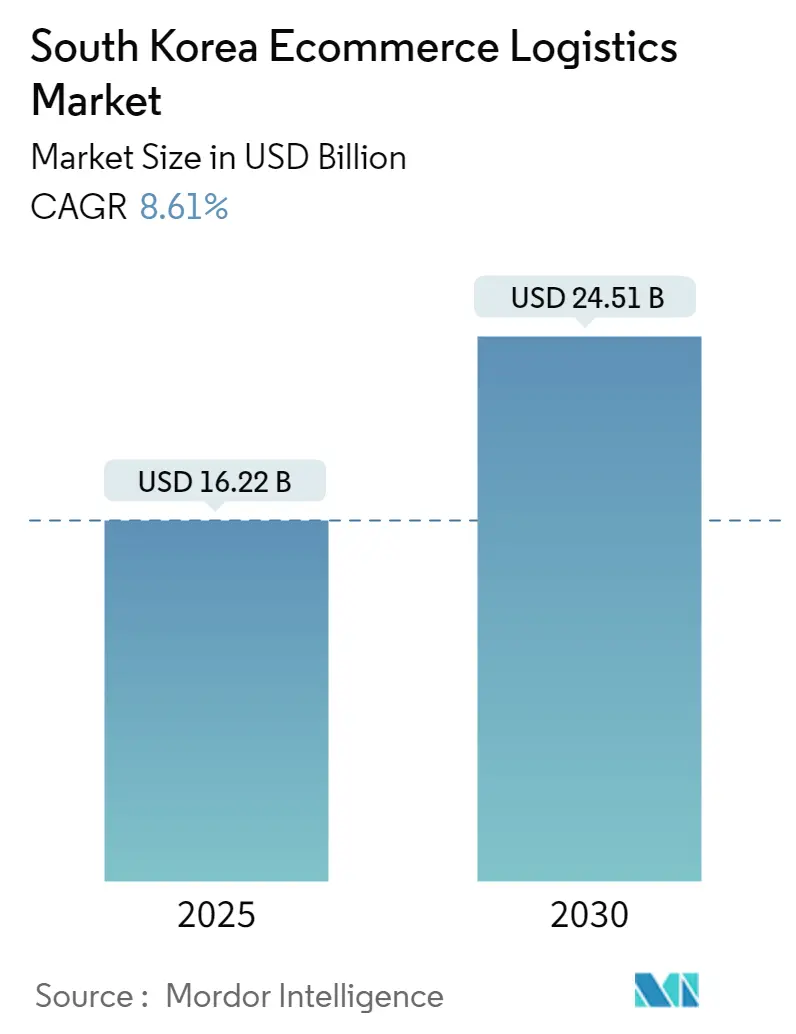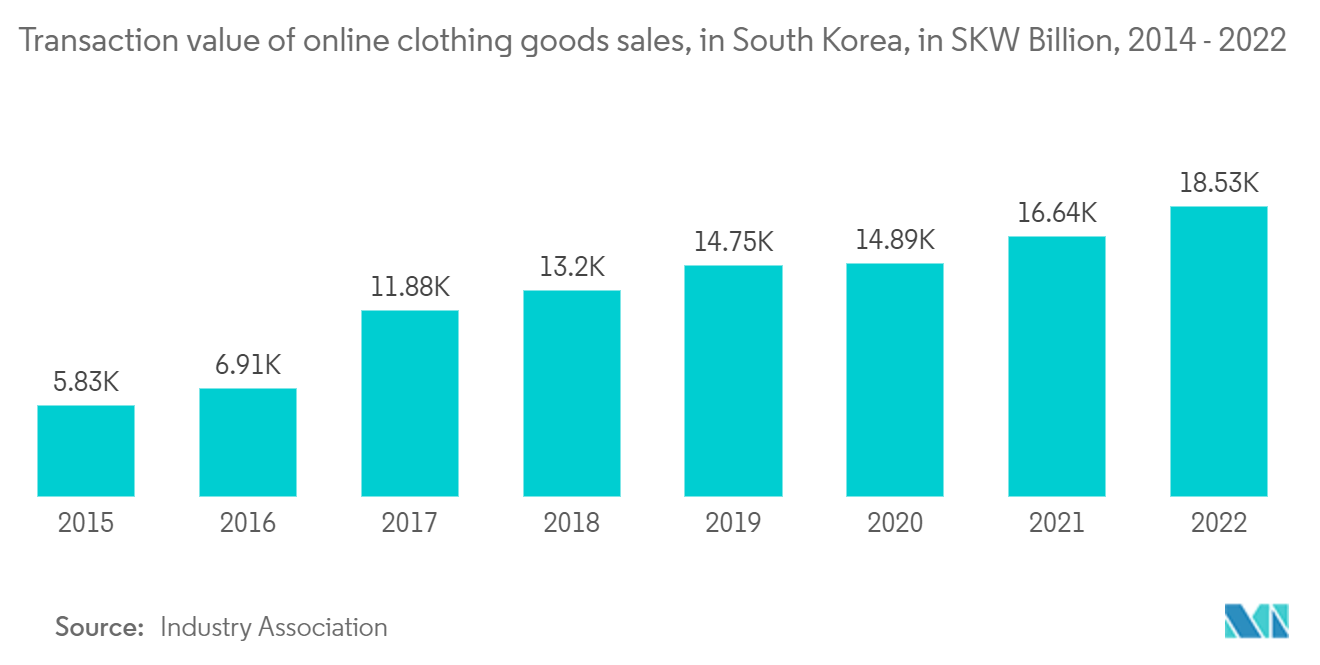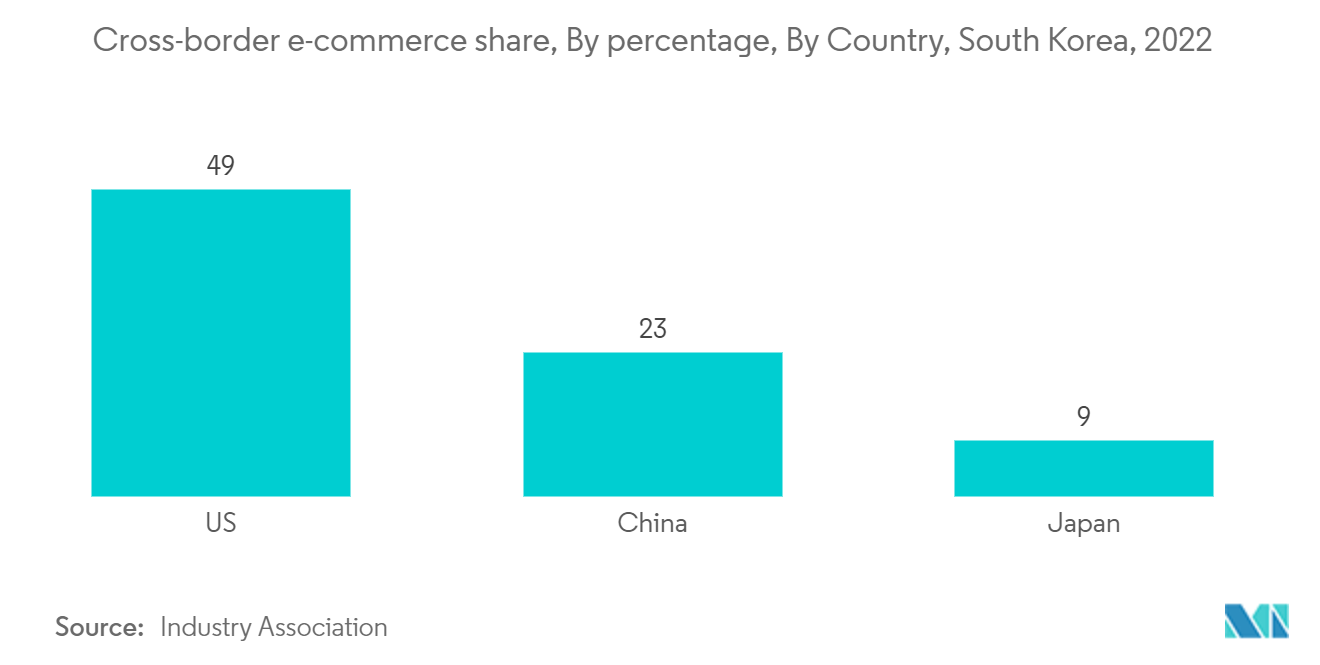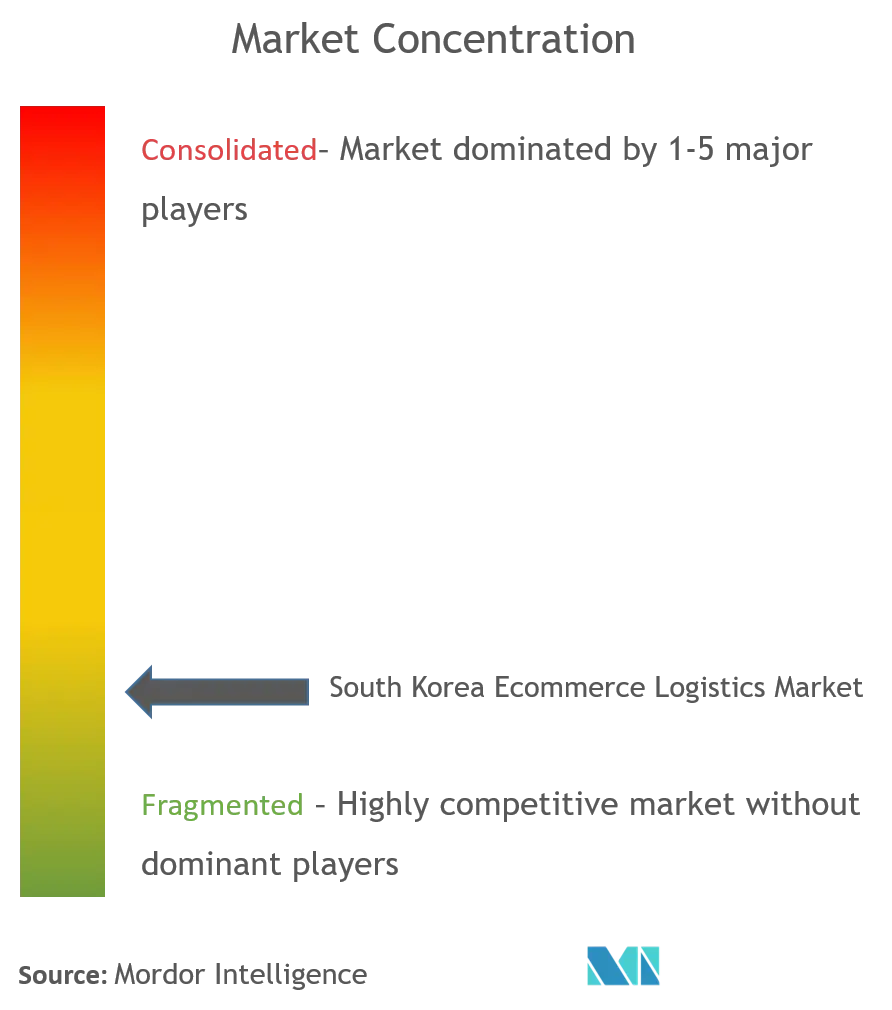
| Study Period | 2019 - 2030 |
| Base Year For Estimation | 2024 |
| Forecast Data Period | 2025 - 2030 |
| Market Size (2025) | USD 16.22 Billion |
| Market Size (2030) | USD 24.51 Billion |
| CAGR (2025 - 2030) | 8.61 % |
| Market Concentration | Low |
Major Players.webp)
*Disclaimer: Major Players sorted in no particular order |
South Korea Ecommerce Logistics Market Analysis
The South Korea Ecommerce Logistics Market size is estimated at USD 16.22 billion in 2025, and is expected to reach USD 24.51 billion by 2030, at a CAGR of 8.61% during the forecast period (2025-2030).
South Korea is in a growing stage and has a moderately fragmented market with around 100+ domestic and foreign players operating in the e-commerce logistics market. CJ Logistics provides integrated transportation and logistics services to individuals and businesses in Korea, covering a wider area than other logistics companies.
Naver, Auction, and G-Market are the leading consumer-to-consumer (C2C) platforms in the Korean e-commerce market. Emerging technologies such as live tracking, automation, WhatsApp bots, AI systems, IoT, and telematics will be major trends leveraged by e-commerce logistics.
As South Korea has a well-developed transportation system, the growing e-commerce sector is expected to eventually create opportunities for intra-urban logistics. Therefore, orders can be easily shipped from one location to another.
The busy consumer lifestyles both partners work in prefer online shopping to waste time traveling from store to store to purchase different products. An online retailer has successfully enabled her to purchase all her needs from one platform, saving consumers a lot of time. Social distancing measures and lockdown enforcement have led to a massive shift to online shopping.
The COVID-19 outbreak prompted most retailers to switch from offline to online (O2O) sales methods. With strong network capabilities, E-Com's logistics companies started partnering with healthcare and food companies for the timely delivery of needed products.
E-commerce players and 3PLs are driving the demand in the logistics market. Third-party logistics accounts for 50.2% of total occupied space, with e-commerce platforms accounting for 24.6%.
The two industries collectively occupy three-quarters of Greater Seoul's leasable logistics space, demonstrating their market dominance. Increased cross-border sales and the growth of online fashion drive the market.
South Korea Ecommerce Logistics Market Trends
Online fashion industry driving the growth of South Korea Ecommerce Logistics
The online fashion industry is one of the fastest-growing industries in the South Korean eCommerce market. According to the country's Ministry of Trade, industry, and Energy (MOTIE), online retail sales in South Korea increased 7.8% year over year (YoY) in February 2023, largely due to a significant increase in demand for clothing and accessories (up 13% YoY due to an increase in outdoor activities and international travel).
In February, offline retail sales in the nation increased by 8% YoY. In February, overall retail sales in the nation increased year over year by 7.9%. The increase in operational days brought on the early Seollal vacations, plus a base impact from the Omicron pandemic, is what is responsible for the boost in sales.
Particularly in physical stores, the clothing and sports sectors saw unusually significant growth. According to the ministry, sales at hypermarket chain stores increased by 5.8% YoY, with sports (up 10.9 YoY), clothes (up 14.5 YoY), and miscellaneous (up 10.8 YoY) all experiencing double-digit growth.
The sales of department store chains climbed by 8.6% as early sales of new spring season merchandise and outdoor activities drove up demand for clothes. Women's casual clothing, children's and sportswear, suits for women and men, and other items all had a double-digit increase.
The sustained trends of modest purchases and proximity shopping were also responsible for the convenience retailers' 10.2% increase in sales. The government conducted monthly surveys of 26 significant merchants, half of which were physical stores and the other half were online.
Large fashion companies like Samsung C & The online fashion industry is one of the fastest-growing industries in the South Korean eCommerce market. Large fashion companies like Samsung C & C&T Fashion Group and LF saw a significant drop in sales and operating profit last year, with sales and operating profit falling by double digits.
The sales of online fashion companies are growing exponentially with the rise of non-face-to-face shopping due to the spread of the coronavirus (COVID-19). The major reason for large corporations showing interest in online fashion companies is to improve their e-commerce (e-commerce) capabilities.
Fashion is an industry with a low online penetration rate, and even large eCommerce companies like Amazon and Coupang have struggled to gain a foothold in it.C&T Fashion Group and LF saw a significant drop in sales and operating profit last year, with sales and operating profit falling by double digits.
The sales of online fashion companies grew exponentially with the rise of non-face-to-face shopping due to the spread of the coronavirus (COVID-19). Since the growth of the industry is high, many companies are expanding their networks by acquiring small companies.
The major reason for large corporations showing interest in online fashion companies is to improve their e-commerce (e-commerce) capabilities. Fashion is an industry with a low online penetration rate, and even large eCommerce companies like Amazon and Coupang have struggled to gain a foothold in it.

Cross border driving the growth of South Korea Ecommerce Logistics
South Korea is the third-largest retail eCommerce market in APAC, following China and Japan, With over 80% of its population using the Internet. Online purchases from foreign retailers are also on the rise, as consumers get goods cheaper from foreign retailers in general; according to a survey by the Korean Chamber of Commerce, 24.3% of respondents confirmed they purchased from overseas websites or buying agencies, citing "lower prices" as their main reason.
According to the Korea Customs Agency, dietary supplements (19.7%), apparel (17.9%), and electronics (11.3%) are the most popular foreign-sourced products purchased from online retailers by Koreans in 2019.
In conclusion, the cross-border B2C e-commerce market offers fresh chances for development and innovation, and the study provides insightful information on forthcoming trends and potential futures for the sector.
The market research provides a thorough analysis of the market's influencing features, including drivers, trends, constraints, key segments, the competitive environment, and other critical components that are considerably boosting the market's growth. Technological advancements and innovation are expected to play a key role in enhancing the performance of the product and expanding its application in various industries.

South Korea Ecommerce Logistics Industry Overview
As the demand for logistics services is growing rapidly across the region, companies are becoming more competitive to capture the huge opportunity. As a result, international players are making strategic investments to establish a regional logistics network, such as opening new distribution centers, smart warehouses, etc. Some of the leading players include DHL Group Logistics, FedEx Logistics, CJ Logistics, SF Express, and Pantos Logistics Etc.
South Korea Ecommerce Logistics Market Leaders
-
DHL Group Logistics
-
FedEx Logistics
-
Pantos Logistics
-
SF Express
-
CJ Logistics
- *Disclaimer: Major Players sorted in no particular order

South Korea Ecommerce Logistics Market News
March 2023: CJ Logistics announced that it launched an integrated brand called “O-NE” that encompasses all its delivery services that connect sellers and buyers. O-NE embodies CJ Group's “ONLY ONE” management philosophy, which pursues the “first, best, and differentiation.” It also has the meaning of “one delivery solution for all,” including sellers and buyers. In addition, the name also contains the excitement and joy of receiving your delivery package anytime, anywhere regardless of what you've ordered. The logo, on the other hand, symbolizes a shipping box on its way to a customer and contains CJ Logistics’ promise to grow together with customers through innovative, cutting-edge logistics services.
March 2023: Cainiao Network, the logistics arm of Alibaba Group Holding Limited, announced that it has partnered with South Korea’s CJ Logistics, a subsidiary of CJ Group whose business spans four major industries, namely food and beverage, biotechnology, logistics, and entertainment and media, to streamline and optimize cross-border logistics services between China and South Korea. In addition, both parties are in the midst of discussions with AliExpress to establish fulfillment centers in South Korea to further safeguard logistics services for local consumers.
South Korea Ecommerce Logistics Industry Segmentation
The term "E-commerce logistics" refers to the transportation, warehousing, and distribution services provided to an online retailer by the logistics company. The report provides a comprehensive background analysis of the eCommerce logistics market, covering the current market trends, restraints, technological updates, and detailed information on various segments and the industry's competitive landscape. The report offers market sizes and forecasts in value (USD) for all the above segments.
The South Korean e-commerce logistics market is segmented by service (transportation, warehousing, and inventory management) and value-added services (labeling, packaging, etc.), business (B2B and B2C), and destination (domestic and international/cross-border).
The report offers market sizes and forecasts in value (USD) for all the above segments.
| By Service | Transportation |
| Warehousing and Inventory management | |
| Value-added services (Labeling, Packaging, etc) | |
| By Business | B2B |
| B2C | |
| By Destination | Domestic |
| International/cross-border |
South Korea Ecommerce LogisticsMarket Research FAQs
How big is the South Korea Ecommerce Logistics Market?
The South Korea Ecommerce Logistics Market size is expected to reach USD 16.22 billion in 2025 and grow at a CAGR of 8.61% to reach USD 24.51 billion by 2030.
What is the current South Korea Ecommerce Logistics Market size?
In 2025, the South Korea Ecommerce Logistics Market size is expected to reach USD 16.22 billion.
Who are the key players in South Korea Ecommerce Logistics Market?
DHL Group Logistics, FedEx Logistics, Pantos Logistics, SF Express and CJ Logistics are the major companies operating in the South Korea Ecommerce Logistics Market.
What years does this South Korea Ecommerce Logistics Market cover, and what was the market size in 2024?
In 2024, the South Korea Ecommerce Logistics Market size was estimated at USD 14.82 billion. The report covers the South Korea Ecommerce Logistics Market historical market size for years: 2019, 2020, 2021, 2022, 2023 and 2024. The report also forecasts the South Korea Ecommerce Logistics Market size for years: 2025, 2026, 2027, 2028, 2029 and 2030.
Our Best Selling Reports
South Korea Ecommerce LogisticsIndustry Report
Statistics for the 2025 South Korea Ecommerce Logistics market share, size and revenue growth rate, created by Mordor Intelligence™ Industry Reports. South Korea Ecommerce Logistics analysis includes a market forecast outlook for 2025 to 2030 and historical overview. Get a sample of this industry analysis as a free report PDF download.




